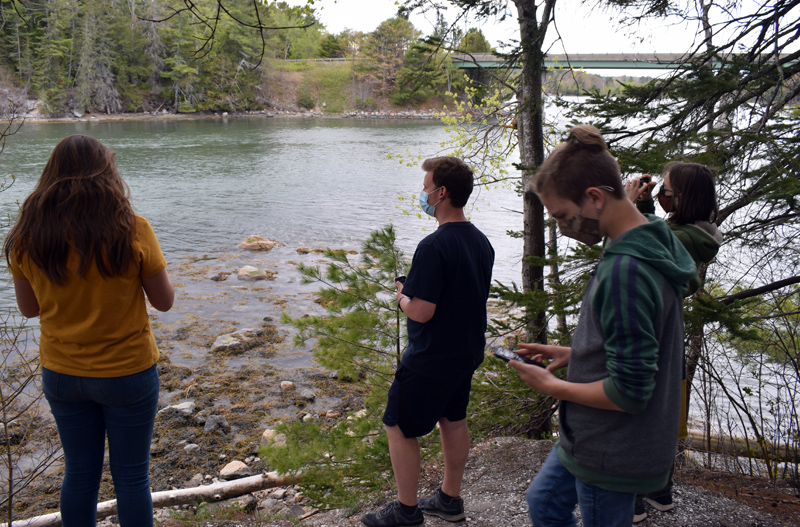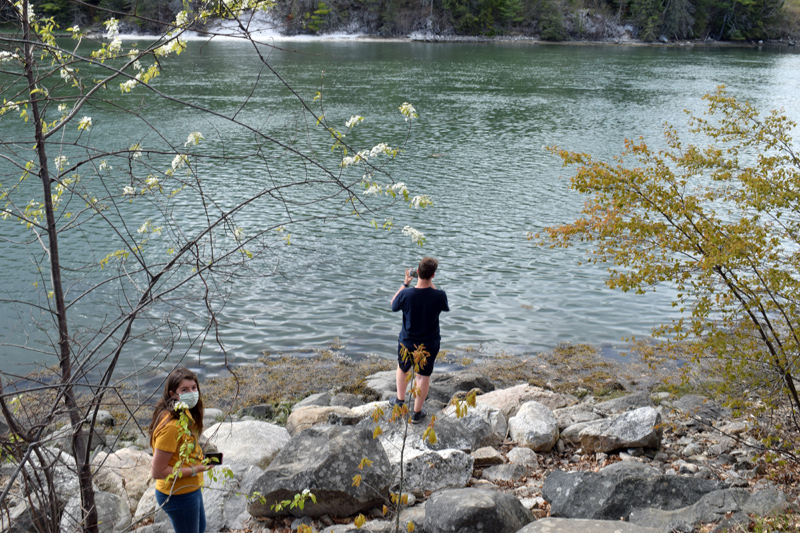
Students in Great Salt Bay Community School’s gifted-and-talented program take pictures and examine a “tour stop” with the STEMports augmented reality app during a field test Wednesday, May 12. (Evan Houk photo)
Four students in the gifted-and-talented program at Great Salt Bay Community School in Damariscotta field-tested an app Wednesday, May 12 that seeks to use augmented reality to educate rural kids about career opportunities in science, technology, engineering, and math.
The students used the app, STEMports, on their phones to engage in a mission at the Whaleback Shell Midden State Historic Site, across the street from the school, and then provided feedback to the app developers.
Students walked along the trail with GSB enrichment specialist Alison Macmillan and members of the development team to watch for “tour stops,” which appear as GPS points of interest on the in-app map, and then completed the stops by reading the information provided.
Susannah Gordon-Messer, of the nonprofit Maine Mathematics and Science Alliance, said tour stops can include instructions, such as “look at the ground” to discover the crushed oyster shells of the midden on the trail, or instructions to identify a nearby solar installation or aquaculture farm.
She said the ultimate goal is to make STEMports a publicly available app with missions spread all over Maine that educate children about STEM careers and nearby opportunities.

Pearce Kelley, of the Maine Mathematics and Science Alliance, left, discusses a mission on the STEMports augmented reality app with Great Salt Bay Community School students, his colleague Brittney Nickerson (second from right), and GSB enrichment specialist Alison Macmillan (right) at the Whaleback Shell Midden State Historic Site in Damariscotta on Wednesday, May 12. (Evan Houk photo)
STEMports is a collaboration between the Maine Mathematics and Science Alliance and the Field Day Lab at the University of Wisconsin-Madison. The collaboration is funded by the National Science Foundation.
The Maine Mathematics and Science Alliance is also partnering with the Maine Organic Farmers and Gardeners Association in central Maine and 4-H programs in western Maine “to help co-design the game with community participants.”
The project’s website says it is “an augmented reality game for community-based STEM learning and workforce development.”
“STEMports engages youth and families in missions (ports) to enhance science, technology, engineering, and math learning, and to help them discover emerging STEM careers in their communities,” the website says.

Helen Duffy and Joseph Levesque, students in the gifted-and-talented program at Great Salt Bay Community School, photograph a Damariscotta River shell midden as part of a mission in the STEMports augmented reality app on Wednesday, May 12. (Evan Houk photo)
According to the Philadelphia-based Franklin Institute, augmented reality projects digital images onto the real-life environment as seen through a phone camera or GPS map. “For example, a pterodactyl might be seen landing in the trees,” the institute’s website says.
GSB eighth grader Eli Melanson said he sees the app as sort of a cross between Pokemon Go, the hugely popular, mobile AR game released in 2016; and geocaching.
Geocaching is a “real-world, outdoor treasure hunting game using GPS-enabled devices,” according to geocaching.com.
Many STEMports missions focus on publicly accessible sites and “may include land labs or land trust properties, old mill sites, research labs and institutes, farms or industrial sites, local state or national park sites, and marine or forest sites of interest,” according to the project’s website.
“Each mission may include content and storylines in the fields of sustainable agriculture and aquaculture, forest products, and renewable energy to mention just a few,” the website says.
The GSB students have also helped develop a mission on the app that serves as an “aquaculture tour” through Damariscotta’s historic downtown.

Susannah Gordon-Messer, of the Maine Mathematics and Science Alliance, speaks to Great Salt Bay Community School students Calvin Percy and Helen Duffy during a field test of the STEMports augmented reality app at the Whaleback Shell Midden State Historic Site in Damariscotta on Wednesday, May 12. (Evan Houk photo)
Gordon-Messer held a brainstorming session after the students finished the hourlong field test on the shell midden trails, gathering the students’ input and seeking local knowledge for the development of that particular mission.
“This is really valuable,” Gordon-Messer said of the brainstorming session.
She urged the students to think about including information in the tour stop blurbs that is not already displayed on signs along the trails.
Gordon-Messer said that most of the fun in STEMports is in augmenting reality and creating a “deep connection to place.”
She said the experience encouraged the students, who have visited the Whaleback property countless times, to slow down and notice new things about the landscape.
Helen Duffy, a seventh grader involved in the project, said before the field test that she was excited to actually experience the mission that the students have been helping to develop through editing software over the last few months.
The students will now send notes to the developers and schedule a full-day field test before the end of the school year.






